 |
|
|
The fisherman has a harmless, preoccupied look; he is a kind of vagrant,
that nothing fears. He blends himself with the trees and the shadows.
All of his approaches are gentle and indirect. He times himself to the
meandering, soliloquizing stream; he addresses himself to it as a lover
to his mistress; he woos it and stays with it till he knows its hidden
secrets. Where it deepens, his purpose deepens; where it is shallow he is
indifferent. He knows how to interpret its every glance and dimple; its
beauty haunts him for days.
John Burroughs, 1886
|
|
|
For years, special regulations have
been in place on the waters of the Upper Yakima River located directly in the
middle portion of Washington State to protect the natural
spawning wild rainbows and cutthroat trout that inhabit the river. |
|
|
|
Misconceptions about the spring,
summer and fall seasons being the only rewarding months to fly fish this
beautiful Pacific Northwest River for these resident trout has been
reinvented and contemplated by a select group of guiding individuals here
at the Worley Bugger.
|
|
|
|
Fly anglers are discovering the
rewards of fishing Central Washington's desert river, the Yakima during
the months of November, December, January and February. |
|
|
|
Many outdoor enthusiasts
participate in a wide variety of activities during the months of winter.
A few examples may be; hunting big game and water fowl, skiing
or snowmobiling
the slippery slopes of your favorite mountain side. Kicking back in your
favorite easy
chair, cheering on your favorite football team to victory isn't a bad way
to spend a day either. |
|
| These are all great activities in their own right. However, many fly
fishermen stow their gear in late October, squandering the opportunity to
experience, what we think can be some of the best fishing the river has to
offer. Crazy you say? Read on and let me elaborate more on the
subject of winter fly fishing below. |
|
|
Yakima
Winter Tour Information-Seasonal |
|
Cost: |
|
Two
Person: seasonal rate |
|
One
Person: seasonal rate |
|
|
|
November
15th to February 28th |
|
|
 All Flies Are Provided All Flies Are Provided |
 Gear Provided If Needed
Gear Provided If Needed |
|
 5 Hours Of
Guided Fly Fishing 5 Hours Of
Guided Fly Fishing |
 |
|
|
| When we refer to
the months of winter, we are generally categorizing the latter days of
November, the months of December, January and February. These
are the months that are typically the coldest in the Yakima River
Valley. Snow fall is occurring at some elevation on a daily basis and daylight
savings time has taken effect. |
|
|
|
|
| What does
this mean in fishing terms? There is less of that warm Central
Washington sunshine during the day to heat the water and air temperature.
So, we as fly fishermen target the warmest portions of these wintry days, which
typically is 10:00 a.m. to 4:00 p.m. Ample time and opportunity,
six full hours to be exact to wet a line in the waters of the Yakima. |
|
|
|
| In November,
Autumn has fully immersed itself across the Yakima River Valley.
Colder temperatures have arrived and the once lush, green foliage that
grew so plentiful under the warm Central Washington sunshine has begun
to wither and fall. The Cottonwood trees, that tower along the
banks of the river, graciously secreted an
array of vibrant Fall colors, are now
nearly barren of their once thick flora. |
|
|
The river this time of year takes on a whole new shape, a whole new
attitude, and a whole new feel.
Its pre-winter conditions throughout the Yakima River Valley and fish of all
species begin to |
|
 |
|
Average Daily
Temperature |
53° |
|
|
shift. They make their move to more appropriate water conditions,
where it is ideal
for them to feed
indiscriminately throughout the day. River flows are typically
low and clear this time of year. Insect hatches become limited,
especially as the month progresses. The initial portions of the
month will still produce an afternoon emergence of Blue Wing Olive
Mayflies. In some areas of the Yakima, where they are predominate in larger
numbers, the big Fall Caddis will also occur at some point during the
day. As the month progress these
important Fall aquatics will diminish and in most circumstances will
not make a reappearance until the new year. |
|
|
Chinook Salmon have breached the mighty electrical dams of the
Columbia River as well as a half dozen barriers that cross the Yakima.
The salmons' tireless journey from the salt water of the Pacific to the fresh waters
of the Yakima occur throughout the season. King Salmon, the fall
persuasion, are
present during this time of year in specific areas of the river. Their
sole purpose and intent; proliferate their species and complete
the circle of life. With their massive bodies, they ravage bone
and sinew, scouring the rocky stream bed of any unsightly debris.
Here, they deposit their eggs and the cycle of one life ends and the rebirth of another in the
approaching spring.
That of course is another story. |
|
| |
Yakima River November Rainbows |
|
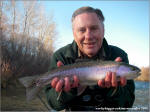 |
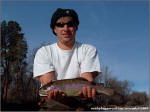 |
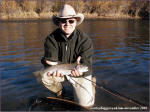 |
|
November |
November |
November |
|
|
|
|
The Yakima is home to a host of bait fish, which include the Sculpin,
Dace, Stickelback and Shiners. The Sculpin is a small
river bottom dweller and an important food source throughout the year.
They are also a winter spawning fish
and their procreations become very active during the latter parts of
November. The Sculpin, like many other aquatic critters, are vulnerable this time of
year. An increase in their activity and the lower water conditions
make them a prime winter target for trout.
The Sculpin just happen to be one of the Yakima Rainbow's favorite food
sources. They hunt them when they can and make a meal of them
whenever possible. |
|
|
A large population of resident Rocky
Mountain Whitefish also reside in the Yakima River. This adipose intact descendant of the trout, are also
a winter spawning fish and begin their spawning ceremony over
the gravely bottoms of the Yakima in late November. Like many Pacific Northwest
Rivers, a catch and kill season is offered on Whitefish beginning the first day of
December to the last day of February. Many of our respected, elder generation of fishermen will
converge along the banks of the
Yakima during this time of year, catching this boney, oil
filled game fish to line their smokers. Each fishermen is allowed 15 fish
per creel, per day during the length of the season. |
|
|
We do inexplicatively catch a few Whitefish during the day, when
targeting trout this time of year, mainly due to their increased
activity as well as lower water conditions. |
|
|
|
|
|
By December, the winter mode
of fishing is in high gear. The average daily temperature now
has dropped about ten degrees. Snow accumulations are building in
the high elevations of the Cascade Mountain Range, a massive, rugged
partition of stone, which divides the city of Seattle and the Yakima River
Valley. The banks along the Yakima this time of year are sheeted with a
insulating foot of snow or more. The day time temperatures are reaching
the low 40 degree mark. Cool, but far from uncomfortable. |
|
|
|
This time of year, aquatic
insect activity is limited. An afternoon hatch of Midges and
Winter Stoneflies will occur, however there is never a guarantee
or a consistent pattern in either insect |
|
 |
|
Average Daily
Temperature |
42° |
|
|
from day to day. Most afternoons, some
sort of Chironomid activity is happening. If there is a populous
of them forming along the waters edge, you can find some fish
harvesting small adults or clusters in the shallow water. |
|
|
|
|
A more consistent
form of fly fishing during the month of December will be a nymph tactic or a streamer style approach.
The same aquatic events that were happening in late November will
continue throughout the winter month of December. Both Whitefish
and Sculpin will continue on their spawning ritual, increasing the
procreation activity as the air and water temperatures cool.
This activity occurs
most often during the warmest part of the afternoon. |
|
|
| |
Yakima River December Rainbows |
|
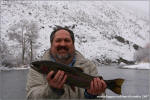 |
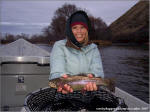 |
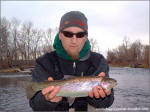 |
|
December |
December |
December |
|
|
|
A nymphing strategy is in order here. A
dry-line approach with an indicator attached to line and leader will
be the effective. A nine foot, 5 or 6 weight fly rod is ideal. For many, nymph fishing with indicators
or in some terms 'bobbers" is not a
favorite form of fly fishing. Perhaps, a lack in the basic understanding
or the
principles behind the art of nymph or wet fly fishing has never been fully explained. Once the ideology
and theory behind the indicator is clarified, most fishermen take to
it quickly and find a new arsenal in their fishing. These are
great months to hone your nymph fishing skills with a professional
instructor. |
|
Streamer tactics can vary this time of
year. A short, quick sinking tip line can aid in delivering the Sculpin
imitation to the required depth. Especially as the fly swings across
the current. Gravity, as well as the power of the water pulls
the fly upward as it comes across the
current. The sinking tip line helps keep the fly deep during
this period |
|
|
Its the holiday season and
the hustle and bustle of December speeds quickly. If weather and
water conditions remain consistent and our daily temperatures stay
within the seasonal average, the month of December can be provide some
fun and exciting fishing. The resident rainbows are now schooled in big pods in
specific water types throughout the Yakima and figuring out their diet isn't rocket science.
It's a matter of knowing the river, the behavior of fish and what it
takes to find them.
The water volume is generally low and it's the time of year when your
chances of
hooking a big, burly
Yakima River Rainbow are in the fly fishermen's favor. Merry
Christmas! |
|
|
|
| It's the
start of a new year and the beginning of yet another season on the Yakima River.
Happy New Year! If I
had to say, January is probably the most inconsistent month for
fishing, period . This is mainly due to the inconsistency in Central
Washington's weather. This
is the coldest month of the year in the river valley and at times recording
mercury levels well below zero isn't uncommon. Big,
thick fog banks form from the Columbia River Basin and sock the
picturesque Ellensburg Valley in dense cover, sometimes for days. When this occurs, air temperatures
are restricted and that warm portion of the day that we need for
productive fishing becomes even more
limited. |
|
|
If these cold temperatures do occur, slush ice will form in the river
creating difficult conditions for any type of fishing. Slow
moving, standing water portions of the Yakima will completely freeze
over or create huge ice caps and snow shelves leaving only a few feet
of moving water to flow. |
|
However, with temperature inconsistencies there are also patterns of weather
that will provide fruitful fishing days in the month of
January. Some afternoons, the warm Kittitas Valley sunshine |
|
 |
|
Average Daily
Temperature |
38° |
|
| will be
beaming brightly across the Columbia
Basin, burning away the low lying fog banks and providing adequate warm air
for comfortable fishing conditions. These are the days to target trout in January.
Watching the extended weather forecast and predication for the
upcoming days high temperatures can be helpful. |
|
|
| |
Yakima River January Rainbows |
|
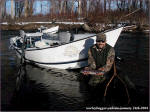 |
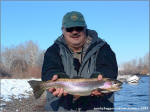 |
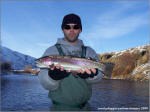 |
|
January |
January |
January |
|
|
|
|
Aquatic insect activity
stays primarily the same in the month of January, expect for one
significant change. Skwalla Stonefly nymphs begin migrating
throughout the winter months, forming in considerable numbers along
the shorelines of the Yakima. In January, this stonefly exodus
will intensify and thousands of these stoneflies will make their
journey to the banks of the river. Resident fish of all species
will gluttonously fill their already bulging bellies on these large
aquatic nymphs before the Skwalla's miraculous metamorphosis to adult hood in
February. |
|
|
|
This is the golden age of
technology, the 21st century. We've put Neil Armstrong on the
moon and set down a lunar rocket on Mars, surely there is gear warm
and comfortable enough for January fly fishing conditions on the
Yakima. High tech gear is available to all outdoor enthusiasts
and for the fly fishermen there is no exception. Breathable waders,
reinforced with multi -layers of Gore-Tex are available as well as a
variety of warm, insulating layering pieces to wear appropriately
underneath. It's easy and in most cases it's a one time shot on
your pocket book. The good stuff can be expensive, but it will
last you for years and if you use it, you get more than your monie's
worth. |
|
|
If I haven't persuaded you
thus far about fly fishing the Yakima in late November, December or
January get ready, because February is on the horizon and things are
about to get really interesting in the coming month. |
|
|
|
| February has
arrived and the landscape in the Yakima River Valley is beginning to
look much different now. The cold, foggy days of January are
shades of the past and a much warmer climate is on the horizon.
The low lying snow, especially accumulations that have collected in
the Rodeo City over the winter are quickly dissolving under the
warm afternoon sunshine. Even the low lying snow around the
hillsides of the river is beginning to disappear. This month,
the average daily temperature will skyrocket almost fifteen degrees
from what had occurred in January. Fifteen degrees may not seem like
much, but for this time of year it is mammoth. |
|
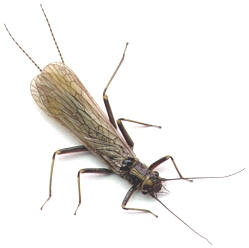 |
| With the warming
temperatures, many interesting events are beginning to happen
on Central Washington's Yakima River. Monitoring
water temperatures very closely, we begin to see adult
stonefly activity when the water temperature reaches a
modest 42°
degrees.
|
|
| This is the
beginning stages of our post winter stonefly hatch, the Skwalla
(pictured left).,
the first large aquatic insect hatch of the new season.
As water temperatures become warmer, we see more of these
large pre-spring plecoptera insects along the waters edge of
the Yakima. |
|
|
Many fly fishermen are just beginning to learn about the
wonders of this post winter stonefly and its emergence in
our great Pacific Northwest Rivers. |
|
|
For years, fly fishermen in Southwest Montana
have been breaking up their cabin fever and heading to
several area rivers for this early stonefly hatch. The Bitterroot, Rock Creek and the Clark Fork
Rivers just to name a few. Its just been in recent
years that Yakima River fly fishermen have acquainted
themselves with our terrific hatch of Skwalla Stoneflies on the
Yakima. |
|
|
 |
| The
first initial appearance of Skwalla Stones on the Yakima, generally occurs a couple
of |
|
Average Daily
Temperature |
51° |
|
|
| weeks ahead
of the hatch on
Montana rivers as well. Once again, mainly due to weather and water
conditions. The warmer weather in the Kittitas Valley sparks this
emergence of stoneflies, a couple of weeks prior to the one that
occurs in Montana's,
Bitterroot Valley. Tracing back over the years of my Yakima
River Fly Fishing Journal, it's typical to
find our first encounter with these stoneflies in the first
week to ten days of February. Skwalla fishing is underway
on the Yakima and casting big dry flies for Yakima River Rainbows has
begun. |
|
| I have to
agree with most fly fishermen. Casting dry flies can be some of the
most exciting fishing we experience. The only problem is, dry
fly fishing isn't always the most productive method of catching fish.
It's a proven fact that 90 % of the trout's diet consists of sub
aquatic invertebrates. However, when big stoneflies
make their appearance this proven fact could easily be disputed. During the
peak period of this or any stonefly activity for that matter, trout are aware of their
presence and routinely hunt these big spring stoneflies, eagerly anticipating
a mouthful of these big belly
filling meals. |
|
| In order to
understand the feeding behavior of trout during this period, I believe
you must first understand
the nature of this post winter
stonefly. Like most stoneflies, the Skwalla is a migrating
insect, crawling along the river bottom to shallow water, usually
around the shoreline of the river where they can conceal themselves
below small to medium size river rock boulders. Once in shallow
water, they wait for the ideal water temperature to crawl out from the
skinny water to the brushy banks and begin their metamorphoses from stonefly nymph
to stonefly adult. |
|
| |
Yakima River February Rainbows |
|
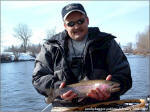 |
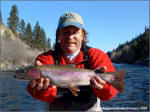 |
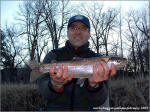 |
|
February |
February |
February |
|
|
|
|
The maturing nymph splits open across the top of its body and leaves its
pre-adult cocoon or exoskeleton
behind. It transforms into a
long, thin, elongated winged flying insect. It is
now ready to find an ideal suitor. Once procreation has taken
place and the female is ripe with a tailing egg sack, she will return to the water to
deposit her eggs to insure the next generation of stoneflies.
This is a continuing cycle that occurs each year on the Yakima,
generally for a 3 to 4 week period, with the peak of the action being
toward the end of February or the first few days of March. |
|
|
Since the Skwalla is a post winter, pre spring insect its movements
both on and off the water are what you may expect for February.
Some females fly, others don't. Sometimes dropping just off the
bank and floating along the stream's edge is adequate for them.
The weather is cooler than what it will be in May, when the
Pteronarcys
Stonefly, the Salmonfly is emerging on the Yakima.
Because of this fact, the Skwalla is not an aggressive mover on the
water. It doesn't flip and flail its wings like our late spring
and summer stoneflies. Most of the time they free float, drag free on
the surface and usually along the bank's edges. Here, trout lie
and wait anticipating at anytime a spring stonefly to come helplessly
floating along. Gulp! |
|
|
Don't make the mistake either of not throwing a big dry fly pattern
around this time of the year. You don't need to see them on the
water or haplessly flying through the air for the imitations to be
productive. Once the trout begin eating them, they're looking for
them. Pick patterns that are suited to this time of year's water
conditions as well. If you do, you can experience some of the
finest early fishing the Yakima has to offer. |
|
|
|
|
| As you can
see there is no shortage of food during the colder months of the year
for the Yakima River Rainbows. Hibernation occurs within the
animal kingdom among the larger mammals and reptiles. Fish
continue on their relentless consumption of aquatics, slowing down
only when necessary or when their metabolism requires it. There is always something to eat
flowing in the water columns of the Yakima and something always
looking to eat it.. |
|
|
If you experience cabin fever, boredom or are just plain restlessness
during the winter months, break
out your fly fishing gear and head to the Yakima River
in Central Washington. You may be surprised and find out just what you have been
missing all this time. |
|
|
If you are unsure about current conditions, check out the
Worley Bugger website and the
Yakima River Fly Fishing Journal. It's an up to date,
honest report of river and fishing conditions. You can
also sign up for our weekly email river journal.
sign up
|
|
|
Each week delivered to your email inbox, you will receive an
up to date and accurate account of
what is happening on the Yakima
River. It includes current hatches, fishing and river conditions along with a host of other vital
information you will find useful. You can also visit our
pro shop in
Ellensburg. A member of our staff will be happy to
assist you with any information you may need to make your
winter fly fishing excursion a success. |
|
|
You may also want to consider hiring one of our full- time
professional fly fishing guides for the day. If you have
never fished the Yakima this time of year, or for that matter
anytime of the year, employing one of our professional
instructors will be a fun and rewarding experience for you.
Fly fish from a warm, comfortable drift boat and enjoy the
winter wonderland as you float the Yakima River. We have
seasonal guided rates throughout the months of November,
December, January and February. |
|
|
Warm,
Comfortable Drift Boat Fly Fishing |
|
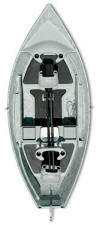 |
|
|
| If you do
schedule a winter fly fishing trip with us, we would also like to note
that should circumstances become severe due to unforeseen weather,
road or river conditions, Worley Bugger Fly Co. will reschedule your
guided tour for a later date when conditions have improved. |
|
| Our
professional guiding team and pro shop staff members constantly monitor stream
and fishing conditions on the Yakima River. If you have any
questions about our professional services or the many fly fishing
adventures we offer, please feel free to contact us toll
free-(888)-950-FISH (3474). We will be happy to answer any
questions that you
may have. |
|
|
We look forward to hearing from you and showing you the splendor of
Central Washington's, Yakima River. |